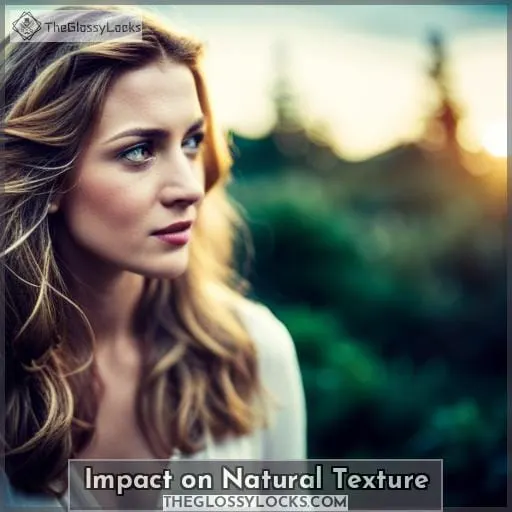This site is supported by our readers. We may earn a commission, at no cost to you, if you purchase through links.
 Imagine this scenario: you’re standing in front of the mirror, eyeing those pesky split ends. You’ve been contemplating whether cutting them is really necessary. Well, let me tell you what happens if you don’t cut split ends.
Imagine this scenario: you’re standing in front of the mirror, eyeing those pesky split ends. You’ve been contemplating whether cutting them is really necessary. Well, let me tell you what happens if you don’t cut split ends.
Your hair may become more prone to breakage and external damage from friction with clothing and accessories.
But fear not! In this article, we’ll explore the effects of not trimming those split ends and provide preventative measures for maintaining healthy hair.
Table Of Contents
Key Takeaways
- Risk of stunted hair growth due to breakage
- External damage from untreated split ends
- Impact on natural texture
- Weakening of naturally curly hair ends affects the natural shape
Effects of Not Cutting Split Ends
If you choose not to cut your split ends, one of the effects you may experience is a risk of stunted hair growth due to breakage.
Split ends can cause further damage up the hair shaft, leading to breakage and preventing your hair from reaching its full potential length.
To maintain healthy ends without regular trims, it’s recommended that you dust your hair every season by removing only a small amount of length.
Additionally, incorporating nutritional supplements that support overall hair health can help promote stronger strands and minimize the impact of split ends on growth.
Risk of Stunted Hair Growth Due to Breakage
If you don’t cut split ends, you risk stunting your hair growth due to breakage. To prevent this risk and maintain healthy hair growth, it’s important to implement effective strategies for preventing breakage and managing split ends.
Some key insights for length maintenance and promoting optimal hair health include:
- Regular trims to prevent split ends from traveling up the hair shaft
- Incorporating growth-promoting techniques into your routine
- Utilizing nourishing products that support overall hair health
- Adopting protective styling practices
- Following a balanced diet rich in nutrients essential for healthy hair growth
Recommended Dusting Every Season to Maintain Healthy Ends
To maintain healthy ends and prevent further damage, it’s recommended that you dust your hair every season.
Seasonal trimming helps maintain the overall health of your hair by preventing split ends from traveling up the shaft and causing breakage.
By regularly caring for your ends, you can preserve length and promote healthier hair growth.
Don’t neglect end maintenance; take proactive steps to ensure the longevity of your locks.
Nutritional Supplements That Support Hair Health
You should consider incorporating nutritional supplements that boost hair health to counteract the effects of not cutting split ends. These supplements can provide growth support and improve the overall condition of your hair from within.
By including these dietary wellness enhancers in your routine, you can promote healthy hair growth and prevent further damage to your strands.
Nutritional supplements specifically designed for hair health can help strengthen damaged hair and reduce the occurrence of split ends, allowing you to maintain long, beautiful locks.
External Damage From Untreated Split Ends
If you don’t cut your split ends, continuous friction with clothing and accessories can cause damage to the hair cuticle.
- Increased breakage
- Loss of shine
- Dryness in the hair
To repair and protect damaged hair, it’s recommended to:
- Use deep conditioning masks and clarifying shampoos regularly.
- Use a silk pillowcase during sleep to help minimize friction on the hair strands and reduce external damage.
Continuous Friction With Clothing and Accessories Damages the Hair Cuticle
Untrimmed split ends subject the hair cuticle to continuous friction with clothing and accessories, leading to damage over time.
To prevent this external damage from untreated split ends, it’s important to take measures such as practicing friction prevention through protective styling and fabric choices.
Incorporating these habits into your hair care routine can help minimize the risk of hair breakage caused by friction with clothing and accessories, keeping your locks healthy and free from damage.
Using Deep Conditioning Masks and Clarifying Shampoos to Repair and Protect Damaged Hair
Continuing the discussion on external damage caused by untreated split ends, deep conditioning masks and clarifying shampoos are essential for repairing and protecting damaged hair.
- Deep conditioning masks provide intense moisture and nourishment to repair hair damage.
- Clarifying shampoos remove buildup from styling products, restoring the natural shine of your hair.
- Hair masks strengthen and fortify strands, preventing further breakage.
Using these products regularly helps maintain healthy, moisturized hair while minimizing the effects of untreated split ends.
Benefits of Using a Silk Pillowcase to Minimize Friction During Sleep
One way to minimize friction and reduce external damage from untreated split ends is by using a silk pillowcase.
Silk pillowcases provide numerous benefits for hair maintenance and sleep quality. They help prevent frizz, as the smooth texture of silk reduces friction between the hair strands and the fabric. Additionally, silk’s natural properties can promote skin health by minimizing irritation and reducing moisture loss during sleep.
Investing in a silk pillowcase can contribute to your beauty sleep routine while supporting long, healthy hair habits.
| Benefits of Using a Silk Pillowcase |
|---|
| Helps prevent frizz |
| Reduces friction on hair |
| Minimizes breakage |
| Promotes healthier-looking skin |
Impact on Natural Texture
When you don’t cut your split ends, it can weaken the ends of your naturally curly hair, impacting its natural shape.
Regular trimming is essential for revitalizing curls and restoring their proper shape.
It’s important to consider your natural texture in order to maintain healthy and vibrant curls.
Weakening of Naturally Curly Hair Ends Affects the Natural Shape
If you don’t regularly trim your split ends, the natural shape of your curls will gradually weaken. This can have a significant impact on the overall texture and appearance of your hair.
To maintain healthy, vibrant curls, it’s important to incorporate proper curl maintenance into your haircare routine. This includes using styling tips that promote moisture balance and protecting your ends with protective styles.
By taking these steps, you can preserve the natural shape and beauty of your curly hair while promoting its growth rate.
Revitalizing Curls and Restoring Their Shape Through Regular Trimming
To revitalize your curls and restore their natural shape, regular trimming is essential.
Implement trimming techniques into your haircare routine to maintain curl integrity and length retention.
Different hair types and textures require customized approaches, but consistent trims help preserve vibrancy across all curl patterns.
Prioritize restoring hair integrity through strategic trimming.
Importance of Considering Natural Texture in Maintaining Healthy Hair
You must consider your natural texture when maintaining healthy hair, as weakening of the ends in naturally curly hair affects its natural shape. To preserve and enhance your curls, you need to take specific care of your textured locks.
Here are three key considerations for maintaining healthy hair with natural patterns:
- Texture-specific care products that provide moisture and define curls.
- Styling techniques that minimize manipulation and heat damage.
- Understanding how to preserve the shape of your curls while promoting length gains by managing split ends effectively through regular trims.
[ADDITIONAL INFORMATION]:
Lengthy discussion is required on this subtopic due to its importance in understanding how different textures require tailored care for optimal health and appearance. The impact of not considering one’s natural texture can result in frizz, loss of curl definition, breakage, and overall dissatisfaction with one’s hair.
Natural patterns vary widely from loose waves to tight coils, and each requires unique attention. Curl enhancement can be achieved through proper hydration, styling methods, and product selection. Styling considerations include using wide-toothed combs or fingers instead of brushes, to avoid disrupting curl formation.
Shape preservation involves regular trims, dusting dead ends without compromising desired length gains. Thus, a comprehensive outlook on these aspects will empower individuals seeking liberation, power, intimacy concerning their own unique tresses.
Preventative Measures for Split Ends
To prevent split ends and promote overall hair health, it’s important to regularly trim your hair.
Trimming helps remove damaged ends before they can travel up the hair shaft and cause further breakage.
Additionally, incorporating deep conditioning masks into your routine can repair and protect damaged strands, while adjusting your washing frequency and using clarifying shampoo can help prevent dryness and damage.
Regular Trims to Prevent Split Ends and Promote Overall Hair Health
Regular trims are essential for preventing split ends and maintaining the overall health of your hair. They not only aid in split end prevention but also support length maintenance, texture revitalization, and provide necessary nutritional support for healthy hair growth.
Experts recommend incorporating search and destroy (SD) methods into your long hair care routine to remove individual split ends without sacrificing length.
Following expert recommendations ensures that you have beautiful, healthy hair while avoiding the negative consequences of neglecting split ends.
Deep Conditioning Masks and Nutritional Supplements for Hair Repair and Protection
For optimal hair repair and protection against split ends, it’s essential to incorporate deep conditioning masks and nutritional supplements into your hair care routine.
Deep conditioning masks provide much-needed moisture to combat dryness and frizz while improving the elasticity of your strands. They also help restore shine and prevent breakage by nourishing the hair from within.
Nutritional supplements can support overall hair health, promoting stronger strands that are less prone to damage or porosity issues.
Adjusting Washing Frequency and Using Clarifying Shampoo to Prevent Dryness and Damage
To prevent dryness and damage that can lead to split ends, adjust your washing frequency and incorporate the use of clarifying shampoo.
How often you should wash your hair depends on your hair type and personal preference. If you have oily hair, it may be beneficial to wash more frequently, while those with dry or curly hair might benefit from less frequent washing.
Using a clarifying shampoo once a week can help remove build-up from styling products and hard water, preventing damage to your hair strands. Remember to always follow up with conditioner to maintain moisture balance in the hair shafts for optimal health.
Expert Advice for Healthy Hair
When it comes to maintaining healthy hair, experts offer valuable advice.
Periodic dusting is recommended to maintain the health of your ends and prevent split ends from traveling up the hair shaft.
Additionally, opting for a loose haircut can preserve both length and texture while removing damaged ends.
Using deep conditioning masks and clarifying shampoos helps minimize damage caused by external factors, while silk pillowcases can prevent breakage during sleep.
Recommendations for Periodic Dusting to Maintain Healthy Ends
If you want to maintain healthy ends and prevent split ends, it’s important for you to consider the recommendations of experts in hair care.
Periodic dusting is recommended by professionals as part of a regular hair care routine to maintain healthy ends, promote hair growth, and preserve the texture and length of your hair.
Suggesting a Loose Haircut to Preserve Length and Texture
Continue preserving the length and texture of your hair by considering a loose haircut, as recommended by experts.
A loose haircut allows you to maintain your desired length while removing damaged ends. This approach promotes healthy ends, especially for those with curly hair, helping to avoid breakage and support scalp health.
Utilizing Deep Conditioning Masks and Clarifying Shampoos to Minimize Damage
Next, to minimize damage and maintain healthy hair, experts recommend utilizing deep conditioning masks and clarifying shampoos.
Here are four essential steps to incorporate into your hair care routine for optimal results:
- Deep Conditioning: Use a nourishing mask once or twice a week to restore moisture and improve overall hair health.
- Clarifying Shampoo: Incorporate this type of shampoo occasionally to remove product buildup and impurities that can weigh down your strands.
- Silk Pillowcase: Invest in a silk pillowcase to reduce friction while you sleep, preventing breakage and preserving the integrity of your hair.
- Regular Hair Dusting: Trim off split ends with regular dusting sessions every few months, promoting healthier growth without sacrificing length or texture.
Benefits of Using a Silk Pillowcase to Prevent Breakage During Sleep
Get the benefits of using a silk pillowcase to prevent breakage during sleep and maintain healthy hair.
Silk pillowcases reduce friction, preventing damage and breakage while you toss and turn at night.
By minimizing friction, your hair stays healthier, resulting in longer strands over time.
Invest in a silk pillowcase for stronger, more beautiful locks.
Frequently Asked Questions (FAQs)
How often should I trim my split ends?
To maintain healthy hair, it’s recommended to trim your split ends every 6-8 weeks.
Regular trims prevent further damage and promote overall hair health, allowing for longer growth and a polished appearance.
Can split ends cause my hair to stop growing?
Split ends won’t halt your hair growth, but they can hinder it. Like weeds in a garden, untrimmed split ends can spread damage up the shaft.
Will not cutting split ends make my hair look shorter over time?
Not cutting split ends can make your hair appear shorter over time.
Split ends cause breakage, leading to a loss of length and an unruly appearance.
Regular trims prevent split ends from traveling up the hair shaft and maintain the illusion of longer hair.
Is it possible to repair split ends without cutting them?
Repairing split ends without cutting them isn’t possible. Trimming is necessary to prevent further damage and maintain hair health. Embrace the power of regular trims for liberation from frizz and breakage, ensuring longer, healthier locks.
Are there any natural remedies or treatments for split ends?
To repair split ends naturally, try using:
- Coconut oil
- Argan oil
Regular deep conditioning and avoiding heat styling can also help prevent further damage.
However, trimming is still the most effective solution for split ends.
Conclusion
So, what happens if you don’t cut your split ends?
[Keypoints]Neglecting them can lead to:
- Stunted hair growth
- External damage from friction
- A negative impact on your natural texture
To prevent these issues, regular trims, deep conditioning masks, and nutritional supplements are essential.
Adjusting your washing frequency and using clarifying shampoo can also help maintain healthy hair.
Expert advice recommends:
- Periodic dusting
- Loose haircuts
- The use of silk pillowcases to protect your strands
Don’t let split ends hold you back from achieving healthy, beautiful hair.








